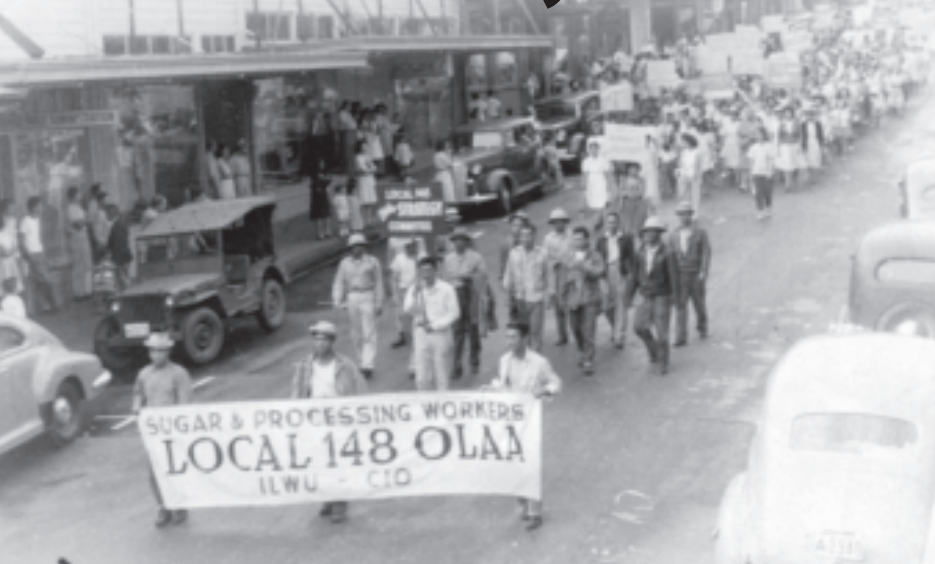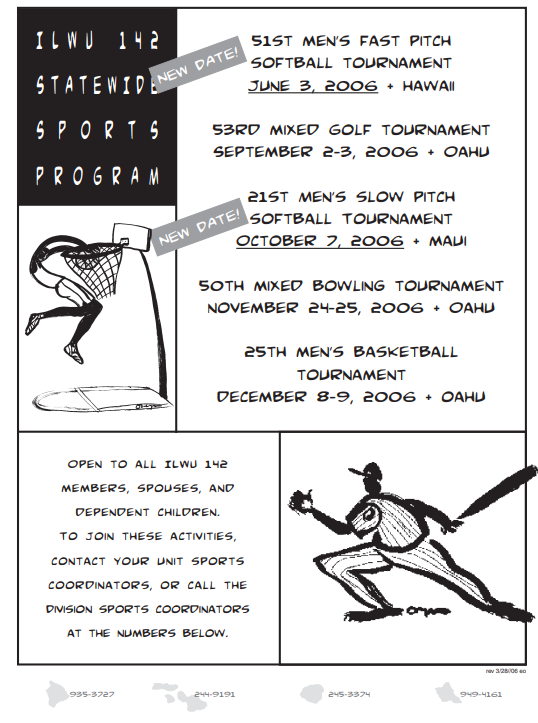 Ethnic unity during the 1944 sugar strike
Ethnic unity during the 1944 sugar strike
During 1944, sugar workers on nearly every plantation organized under the ILWU banner. This time there was only one union that united the workers of every ethnic group. The workers themselves ran the union and became the union’s leaders. ILWU organizers advised workers to elect leaders from each ethnic group and make sure all groups are included in union activities.
Government policy during World War II required management and labor cooperation, so the Big 5 had grudgingly agreed to a one year contract with the ILWU which was set to expire in mid-1946. The Philippines had been occupied by Japan, and one-third of the plantation workforce was Japanese. The sugar industry expected the sakada to have bad feelings toward the Japanese and serve as replacement workers in the event of a strike. The plan was to use the 6000 sakada to weaken and break the union.
The ILWU also expected the showdown in 1946 and knew about the 6000 sakada. ILWU organizers signed up for jobs as cooks and stewards on the SS Maunawili and SS Falcon, the two ships that would bring the Filipinos to Hawaii. During the 15-day voyage, they talked to the sakada and educated them about the union and the need for racial unity. When the sakada arrived in Hawaii, they were already ILWU members.
During contract negotiations, the Big 5 refused to bargain in good faith. Negotiations collapsed, and 25,000 ILWU sugar members voted to strike. The strike would last for 79 days and ended with a victory for the union. It would be the first successful industry-wide, multi-racial strike in Hawaii. Despite the hardships, the new sakadas were strong union members and resisted numerous attempts to get them to break from the union and return to work. ◆

Hawaii and the Philippines
The fate of both countries came together in 1898, a few years before the arrival of the first Sakada. Both Hawaii and the Philippines lost their independence as sovereign nations, and came under the control of the United States.
In Hawaii, the Citizen’s Committee of Safety, a small group of American businessmen and missionary descendants who were making huge fortunes from the sugar business, had overthrown the Hawaiian Kingdom and disposed Queen Lili‘uokalani in 1893. The presence of a American warship in Honolulu harbor and the deployment of its 162 soldiers gave the appearance the U.S. was supporting the overthrow.
The Committee of Safety formed a provisional government and offered Hawaii to the United States. But President Grover Cleveland, a Democrat, concluded the action was illegal and called for the restoration of Queen Lili‘uokalani. While Congress was debating the issue, the Republicans regained a majority in both houses in the mid-term elections of 1894. Two years later, William McKinley, a Republican, was elected president.
President McKinley and the Republican Congress strongly believed that America should become a world economic power with a strong military to protect that power. They believed the U.S. had the right, even a duty, to bring a superior American way of life to less civilized people.
In 1897, President McKinley signed a treaty of annexation with the new government of the Republic of Hawaii, which then had to be ratified by the Senate. The Senate also received a petition signed by 21,269 citizens of Hawaii, which clearly showed a majority were opposed to annexation.
Opposition to annexation grew, and the Republicans were unable to get the necessary two-thirds vote to annex Hawaii by treaty. Instead, they passed a joint-resolution of Congress which only required a majority vote. McKinley signed the resolution on July 7, 1898, and Hawaii was made a part of the United States.
Newspaper war against
Spain While Congress was debating the fate of Hawaii, the American public were reading sensationalized and many faked stories about the Cuban uprising against Spain. Two rival newspaper publishers, Joseph Pulitzer and William Randolph Hearst, were battling to sell more papers than the other, and the big news of the day was the rebellion in Cuba.
The newspapers ran stories about Spanish cannibalism, torture, and deathcamps. The Cubans were depicted as brave and heroic and the Spaniards were cowards and demons. There were stories about battles that never happened. It was more entertainment then news, but it began inflaming public opinion against Spain.
On February 15, 1898, the battleship Maine sank in a mysterious explosion near Havana. The newspapers blamed it on Spain and called for war. On April 20, 1898, the U.S. declared war against Spain. The Cubans and Filipinos had already been fighting Spain for years and did most of the fighting on the ground against the Spanish army. Spain called for an end to the war after losing a series of naval battles with the U.S.
The Philippines
The treaty that ended the war gave Cuba its independence and the United States control of Guam, Puerto Rico, and the Philippines, for which the U.S. paid $20 million. While the U.S. and Spain were negotiating the treaty, the Filipinos adopted a constitution, declared the Philippines an independent nation, and chose Emilio Aguinaldo as its president. Aguinaldo was one of the generals of the Philippine independence army that did most of the fighting against Spain and controlled most of the country. U.S. forces were in control of Manila.
President McKinley had other plans and refused to recognize Aguinaldo or Philippine independence. The U.S. President believed that God had
— continued on page 8
